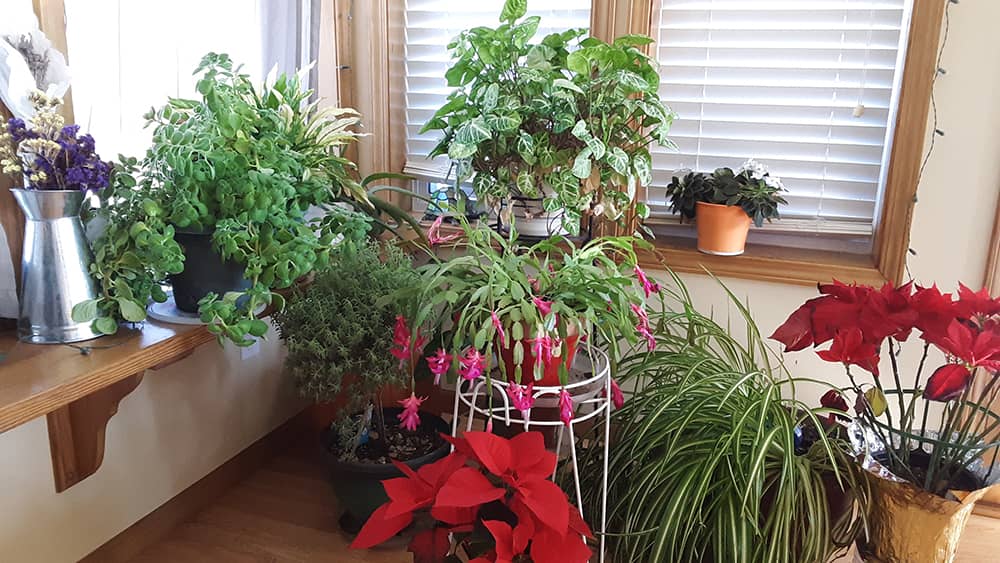
KJFM NEWS — Garden Talk is produced monthly at the Adair County University of Missouri Extension Center in Kirksville, Mo.
This is the time of year your attention may turn to houseplants. It’s nice to have something green and flowering to look at when the days are cold and dreary. Plants are kind of like having a pet that you don’t need to worry about too much. They are an inexpensive way to jazz up even the most boring rooms. Adorn windowsills with succulents, display plants in beautiful ceramic and copper containers, or grow some herbs to use in cooking.
Before you even look for houseplants, assess your space. What is the average temperature and humidity level? What direction do the windows face and how much sunlight shines in? You can buy the prettiest plant, but it doesn’t mean you can keep it alive. Make sure you can provide your plant the optimal environment before making the purchase or adopting a plant. Growing tropical plants in warm, dry homes is not as ideal as growing them in a warm, humid greenhouse or on a tropical island.
For most houseplants, all you often need to do is provide light and water them about every 7-10 days, and they will provide you enjoyment all winter. An indoor garden can be your refuge from the outside world, and for many people it is a source of great joy. Whether you live in a small apartment, or a large house, by introducing plants into your home, you will start to notice improvements to your health, and overall happiness. As well as enhancing your mood and creating a living space that is soothing to be in, plants can also help with loneliness and depression. Caring for plants gives us a purpose and is rewarding, especially when you see that living thing bloom and thrive. Studies have shown that house plants improve concentration and productivity by up to 15%, reduce stress levels, and boost your mood.
Plants release oxygen and absorb carbon dioxide. Extensive research by NASA has revealed that houseplants can remove up to 87 per cent of air toxin in 24 hours. So, placing plants around the house has its’ benefits.
At work, place plants, especially those with broad leaves, on your desk. They will help regulate humidity and increase levels of positivity. Seeing greenery and nature will help you feel more calm and relaxed. Indoor plants serve a practical and aesthetic purpose, and will enhance your life.
You don’t necessarily have to have a green thumb to grow houseplants, but you do need a sunny window. Most indoor plants like bright, indirect like, and do not like direct midday sun, so be wary of this when placing plants in your home. There are very obvious warning signs to look out for, such as leaf burn, spotting or sudden leaf-fall if the plant has received too much sunlight. Do not place plants by a drafty window. This can cause the leaves to curl and eventually drop off. Low light levels will also affect the growth and health of a plant.
Overwatering is the number one cause of death of houseplants. Never overwater indoor plants. Most people kill their houseplants by pouring water down the center of the plant, giving the plant much more water than it needs, and then the water has nowhere to go so it then sits in the plant. Excess stagnant water then causes root rot, which causes the plant to die. Either water from the bottom using a saucer if the plant pot has drainage or mist regularly with an atomizer, which helps to increase the humidity around your plant and keeps your plant healthy and happy.
Plants can be repotted and given some fresh soil during the winter months especially if they are rootbound. Overgrown plants in plastic pots seem particularly prone to tipping over as the soil dries. Roots may begin to grow out of the drainage holes in the bottom of the pot. These are rather extreme signals that your plant probably needed repotting several months ago. Choose a pot of only the next larger size. The soil in pots that are too large tends to stay excessively moist for too long and can lead to root rot. Some plants may already be too large for the existing environment and would only continue to grow larger if given a larger pot. Repotting in this case should only consist of replanting in fresh soil in the same size pot.